Nine Things to Remember About the Future of Copper in Computing
Is copper dead?
Not by a long shot. Copper technology, however, will undergo a dramatic transformation over the next several years. Here’s a guide.
1. Copper is the Goldilocks Metal
Copper has been a staple ingredient for interconnects since the days of Colossus and ENIAC. It is a superior conductor, costs far less than gold or silver and offers relatively low resistance. Copper also replaced aluminum for connecting transistors inside of chips in the late 90s because its 40% lower resistance improved performance by 15%1.
Copper is also simple, reliable and hearty. Interconnects are essentially wires. By contrast, optical interconnects require a host of components such as optical DSPs, transimpedance amplifiers and lasers.
“The first rule in optical technology is ‘Whatever you can do in copper, do in copper,’” says Dr. Loi Nguyen, EVP of optical technology at Marvell.
2. But It’s Still a Metal
Nonetheless, electrical resistance exists. As bandwidth and network speeds increase, so do heat and power consumption. Additionally, increasing bandwidth reduces the reach, so doubling the data rate reduces distance by roughly 30–50% (see below).
As a result, optical technologies have replaced copper in interconnects five meters or longer in data centers and telecommunication networks.
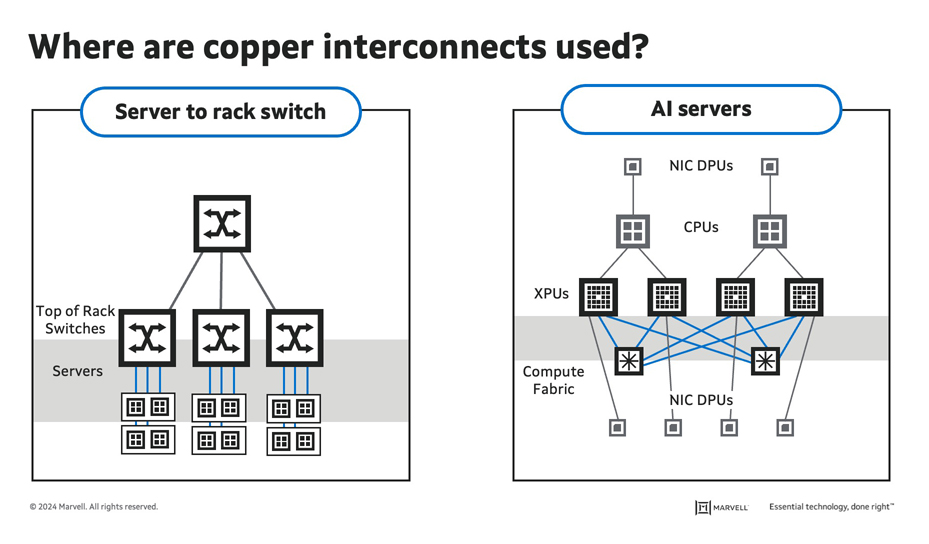
Source: Marvell
3. 200G Marks a Turning Point
SerDes are the atomic units of networking, the elemental input-output structure that ultimately determines the performance of everything else that makes up the network. Current 12.8T networks are composed of millions of 50G copper and optical SerDes. A 400G cable or module will contain eight of them and 32 400G cables will plug into a single switch. 51.2T networks, being implemented over the next few years, will mostly rely on 100G SerDes. Networks that rely on 200G SerDes take off in 2027. That higher bandwidth, however, means a shorter reach.

Source: Marvell
4. The Higher Bandwidth/Shorter Reach Impacts Connections Between Systems and Inside Systems
The copper connections five meters and less can be approximately divided into two categories: cables and wires. Copper cables connecting servers and switches inside the same rack are based on the ubiquitous Ethernet protocol. A traditional Ethernet direct attached copper (DAC) cable can transmit signals for three meters at 5G—enough for today’s racks—but approximately only one meter at 200G. Data center racks are typically seven feet high; thus, even if you put the switch in the middle, 200G Ethernet cables won’t be long enough to connect all of the systems in a rack to each other, barring unnatural engineering tricks.
Chips on the same board or within the same system, by contrast, rely on wire connections leveraging PCIe. The data rates and distances are far lower: PCIe Gen 4 connections carry up to 16GB per lane and can travel up to eight inches. The heat and power constraints are more demanding, the physical connection itself is far thinner and PCIe connections typically require lower latency and greater reliability in packet delivery: the application difference accounts for a large part of the difference in transmission speed.
But, like Ethernet, PCIe faces a distance challenge. PCIe Gen 6 devices (64 GB/lane) can only send data two inches before corruption potentially takes effect. With cloud service providers requiring larger servers and looking at ways to distribute server components across adjacent boards and servers, that’s not nearly long enough. PCIe Gen 6 will begin to appear in systems in the same generation as 200G-based Ethernet.
Copper is also a mainstay in enterprise and small business networks because the bandwidth demands are in the 1–10G range. As a result, longer reaches aren’t as big of an issue at present.
5. The Solution for Ethernet? Bring Optical Componentry to Copper
Active Electrical Cables (AEC) effectively add an optical DSP to the terminal end of copper cables to amplify and fine-tune signals. For instance, the Marvell® Alaska® A 1.6T PAM4 DSP for AECs, introduced earlier this year, is the industry’s first 1.6 Tbps device for this application. While adding semiconductors to the cable increases costs and total power consumption, it extends the distance threefold at 200G and up to seven meters at 50G. At these distances, copper becomes a viable medium for server-to-switch and server-to-server connections as well as for linking systems in AI clusters.
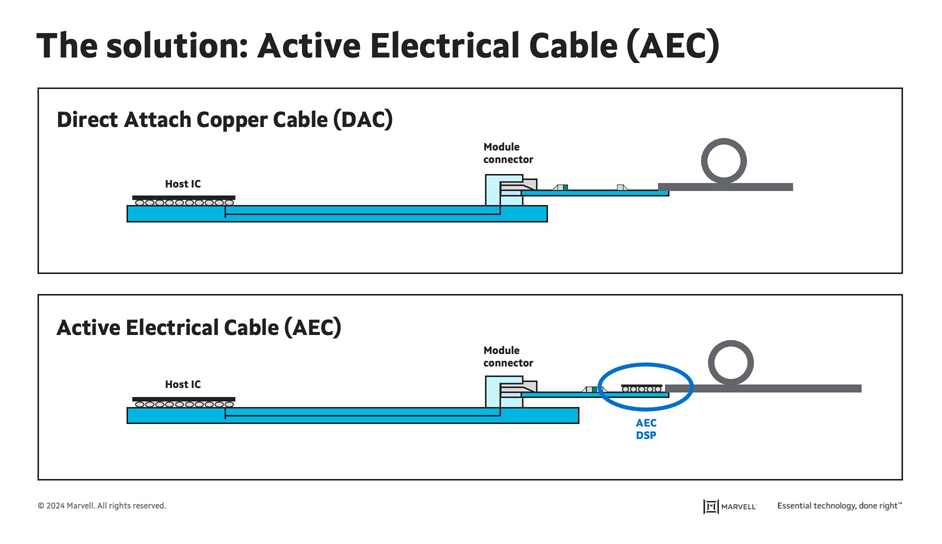
Source: Marvell
The length of DAC cables could be extended by increasing the gauge of the cables. Unfortunately, the resulting extra thickness makes the cables stiff and unwieldly, a significant headache and source of ambient heat for facilities managers.
The DSPs at the terminal end of the cable are housed in familiar, standard modules, easing implementation. TE Connectivity, Molex and Amphenol, among others, are developing cabling solutions with Alaska A 1.6T PAM4 DSP.
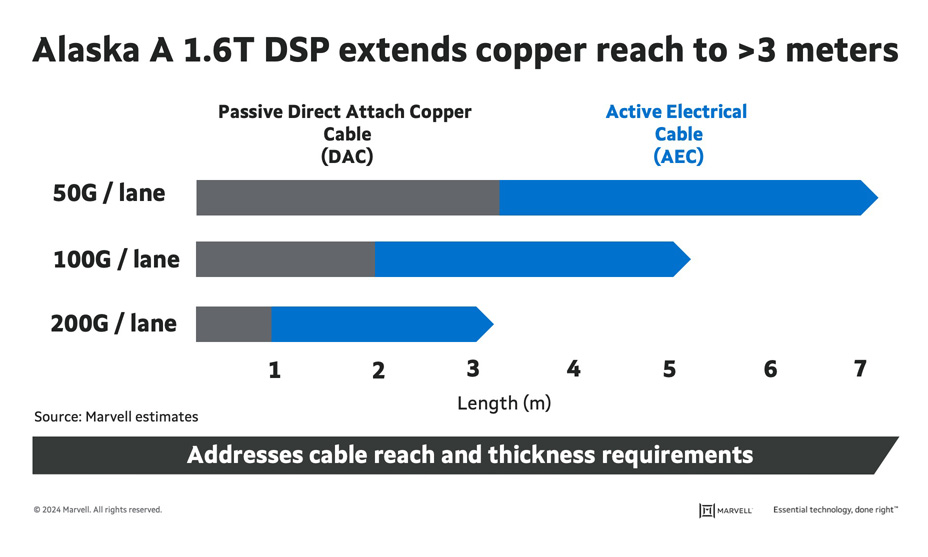
Source: Marvell
Active Optical Cables, meanwhile, also include transimpedance amplifiers and drivers with the optical DSP. AOC cables are capable of transmitting data up to 30 meters to accommodate larger AI clusters and disaggregated systems.
6. For PCIe, Optical Technologies Get Integrated
Like AEC and AOC DSPs, the PCIe retimers represent a new class of devices that extend the length of copper interconnects. The difference revolves around the standard, the use cases and the technologies borrowed from the optical world.
A single 1.6T Marvell Alaska P retimer, released earlier this year, can be used to extend a Gen 4 PCIe link from eight inches to over 20 while Gen 6 PCIe links are extended from two and a half to approximately 17 inches. The longer links open the door to physically larger systems and disaggregated systems that can deliver better performance while reducing thermal hot spots.
PCIe retimers do not integrate optical DSPs or complete components into their own designs. Instead, they retrofit optical technologies and concepts. The 5nm Alaska P, for example, is built around the same SerDes used inside an equivalent DSP. The device also uses the PAM4 modulation scheme, which doubles the data rate. Current PCIe devices use the older NRZ modulation scheme.
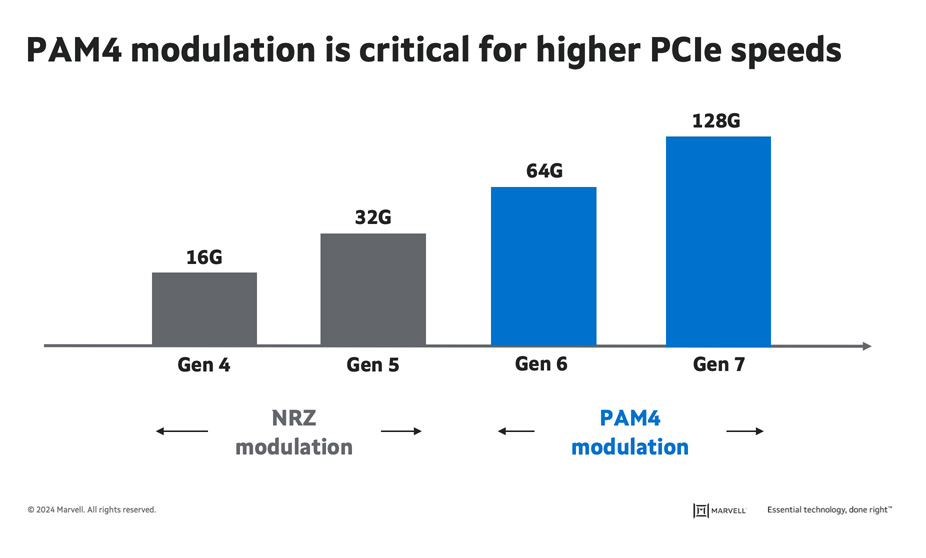
Source: Marvell
And, as stated above, PCIe retimers are employed to connect components with the same system. The Alaska P can be used to link AI processors to each other or to CPUs. The devices can also be used to link GPUs to each other. Additionally, PCIe retimers will likely be deployed to link processors to memory in conjunction with CXL controllers.
Unit volumes will also potentially be substantial. 75% of cloud and AI servers shipping in two years will rely on PCIe retimers and often contain multiple devices, according to the 650 Group. An eight-GPU server, the firm added, could contain 16 PCIe retimers.
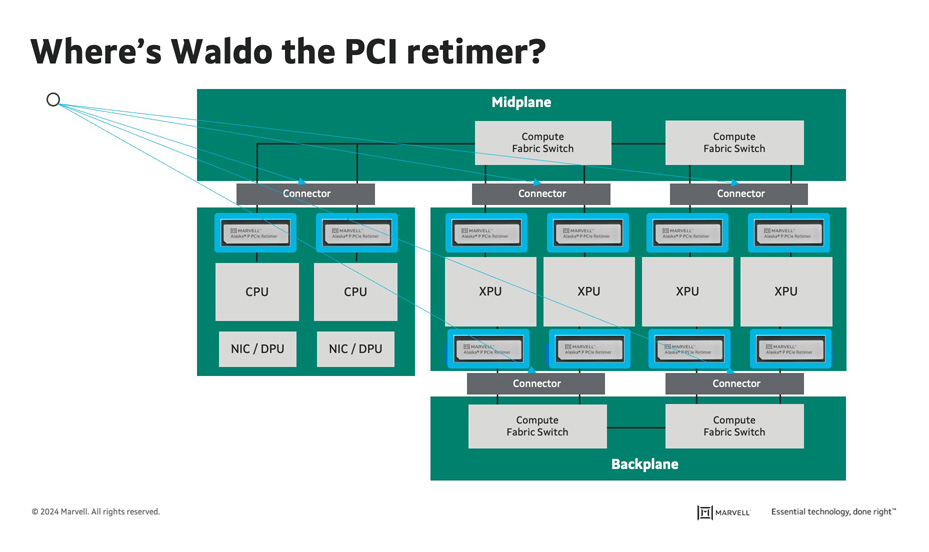
Source: Marvell
7. More Chips Mean More System Intelligence
Like AEC and AOC devices, PCIe retimers can gather telemetry data for improving system performance and predictive maintenance.
8. AI Will Push PCIe Speeds Faster
PCIe Gen 7 SerDes, which can operate at 128GT/second, were unveiled at OCP earlier this month. Here’s a photo.
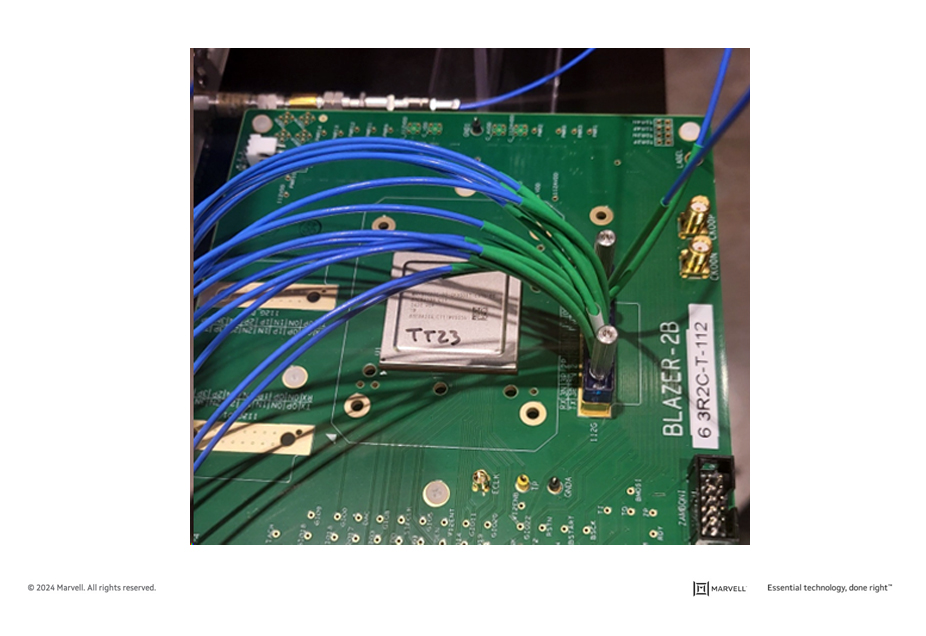
Source: Marvell
9. Next: Optical Inside the Chip
Futurists have discussed the benefits of bringing optical interfaces to chips for decades. Now, a confluence of forces is paving the way. Chiplet designs and advance packaging provide a framework for integrating optical interconnects into semiconductor designs. R&D has steadily advanced and power has increasingly become a bottleneck.
TSMC recently said it is ramping up the development of silicon photonic solutions so that it can have the technology ready for production in three to five years. Optical-enabled chips could constitute a $500 million market by 20283.
Optical could reduce power by 30% or more3, according to Radha Nagarajan, senior vice president and CTO of optical and cloud connectivity at Marvell. Still, AI chips will have to be redesigned to accommodate the interfaces.
1. IBM, 2018
2.. 650 Group, Merchant Silicon Report 2Q 2024. Industry estimates
3. Nikkei Biztech, Sept 2024.
This article contains forward-looking statements within the meaning of the federal securities laws that involve risks and uncertainties. Forward-looking statements include, without limitation, any statement that may predict, forecast, indicate or imply future events or achievements. Actual events or results may differ materially from those contemplated in this article. Forward-looking statements are only predictions and are subject to risks, uncertainties and assumptions that are difficult to predict, including those described in the “Risk Factors” section of our Annual Reports on Form 10-K, Quarterly Reports on Form 10-Q and other documents filed by us from time to time with the SEC. Forward-looking statements speak only as of the date they are made. Readers are cautioned not to put undue reliance on forward-looking statements, and no person assumes any obligation to update or revise any such forward-looking statements, whether as a result of new information, future events or otherwise.
Tags: Active Electrical Cables, 400G pluggable modules, pcie, PAM4 DSP, PCIe Gen 4
Recent Posts
- Custom Silicon: A Sea Change for Semiconductors
- Marvell Named to America’s Most Responsible Companies 2026 List
- 5 Times More Queries per Second: What CXL Compute Accelerators Can Do for AI
- Marvell Makes Inaugural 100 Best Companies in Southeast Asia List
- Marvell Earns “Fittest Firm” Title in Silicon Valley Turkey Trot for 10th Consecutive Year

